 Leading Blog | Posts by Category |
 Leading Blog | Posts by Category |
12.09.22

Trust & Inspire Leadership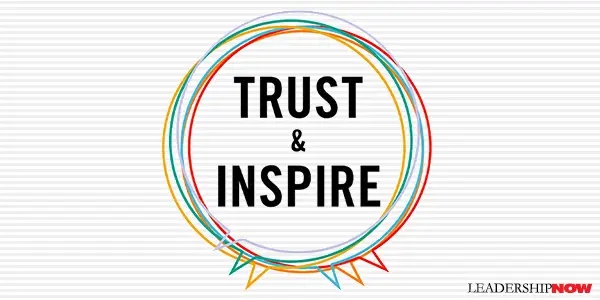
A COMMAND & CONTROL leadership style comes naturally to us. And we resort to it far more than we think. What has always worked better and is required for successful leadership in this day and age is something Steven M. R. Covey calls Trust & Inspire leadership. Trust & Inspire leadership is about “trusting people to do the right thing and inspiring them to make meaningful contributions.” Furthermore, it’s about “connecting people to purpose so they feel inspired not only by an organization’s leaders, but also by a sense of purpose, meaning, and contribution in their work.” When we inspire someone, we breathe life into them. “We rekindle the inner spirit” that so much in life knocks out of us. As opposed to Command & Control, which is transactional, “Trust & Inspire is transformational—it focuses on building relationships; on developing capabilities; on enabling, empowering, and growing people. And the irony is that not only is this the far more enduring approach, it’s actually the more efficient way [in the long run] to get things done as well.” Many of the changes we have seen to the Command & Control approach are “changes in degree, not in kind. We’re still operating within the same paradigm.” So just how do we make the shift to Trust and Inspire? How To Make the Change from Command & Control to Trust & Inspire The shift to Trust & Inspire is a change in our fundamental beliefs. Those fundamental beliefs are based on the understanding that leadership is stewardship. Stewardship is holding in trust those we lead and applying everything we have been given in the service of that trust. “It’s about leaving something in better shape than when we stepped into our role.” Covey’s Trust & Inspire framework breaks stewardship down into three stewardships that work together, and build off each other. Developing Trust & Inspire leadership needs to have all three: Modeling, Trusting, and Inspiring.
Modeling – Who You Are Modeling is built on the idea that leaders go first and are developed from the inside out. “It is the source of credibility and your moral authority as a leader.” Trust & Inspire leaders model three things: Humility and Courage—Authenticity and Vulnerability—Empathy and Performance. Trusting – How You Lead Do we extend trust to others, or do we withhold it? “Trusting—how we lead—flows out of the fundamental beliefs of greatness being inside people and that our job as a leader is to unleash people’s potential, not control them. We unleash the greatness inside people through trusting them.” Not trusting others makes for an exhausting life. It is important to clarify expectations and practice accountability. “When you clarify expectations, you create a shared vision and agreement upfront about what is to be done.” And it is a two-way street. We grow people through trusting. “Great leaders grow people, and nothing grows people better—or faster—than an extension of trust.” Inspiring – Connect to Why Inspiring others “flows out of the belief that people are whole people—made up of body, heart, and spirit—and that the job of a leader is to inspire others from within rather than merely trying to motivate them from without.” Trust & Inspire leaders connect people to Purpose—a sense of contribution (why work matters), People—self, relationships (caring), and team (belonging). Making the Transition Trust & Inspire is a mindset. It becomes who you are even when in some situations you might have to act with authority. But here’s the thing: Trust & Inspire leaders have already built credibility and relationships that allow them to act decisively as needed yet with integrity. The difference between a Command & Control leader and a Trust & Inspire leader, even if their actions are exactly the same, is that their behavior is interpreted completely differently, becomes it comes from a different place. Trust & Inspire is not a hands-off laissez-faire leadership but a very active, committed form of leadership. Making the transition to Trust & Inspire is not easy because it requires a change in fundamentals and beliefs. But the results are worth the effort.

Posted by Michael McKinney at 07:51 AM
06.13.22

Building Trust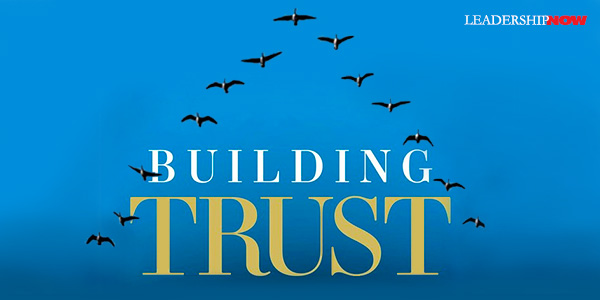
TRUST is what holds relationships together, and therefore it is vital to families, groups, and organizations. Of course, trust is a two-way street. Not only must we be trustworthy, but we must extend trust to others. As leaders, we build trustworthiness in others by first extending trust to them. Trust is based on our behavior. We can behave our way into trust, and we can behave our way out of trust. Understanding the bases of a trust decision can help us to build trust and recover when we have been untrustworthy. The following model introduced by Darryl Stickel in Building Trust: Exceptional Leadership in an Uncertain World, helps us to do that.
The model begins with the bases of trust. When deciding whether to trust or not, people ask two questions: How likely am I to be harmed a (perceived uncertainty) and if I am harmed, how badly will it hurt (perceived vulnerability). When combined they give an idea of our perceived risk. And spending on our risk threshold, we make a decision on whether the trust is worth it. “Our risk threshold, or willingness to trust, comes from a combination of our cultural background, personal traits, and experiences.” Our perceived uncertainty of another person may go down as we get to know them, and as a result, we may be more willing to be more vulnerable with them. But emotions also come into play. Our emotions act like a filter and influence our judgment. The more extreme our emotions—love or hate—the less rational we are. Our emotions affect our trust decision and even the outcome we expect. At the same time, we may trust someone in one context but not another. Change the context, and the perceived uncertainty and vulnerability changes too. We can increase our trustworthiness—our perceived uncertainty—by addressing three factors: Do you have my best interests at heart? (Benevolence), Do you follow through on commitments? (Integrity), and Can you do the job? (Ability). When it comes to vulnerability, scarcity (what do I have to lose?), the stakes (what do I feel is at stake?), and value (what value do I place on the stakes?). 
Posted by Michael McKinney at 07:24 AM
04.09.21

Mayday! Mayday! How to Build Trust in a Crisis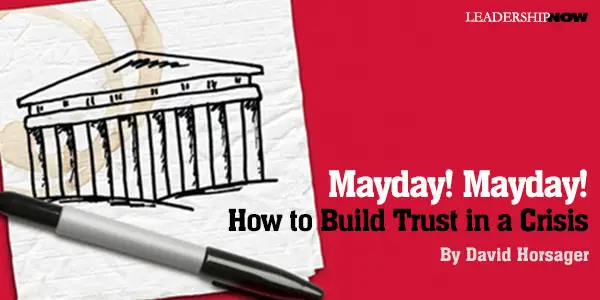
NOTHING reveals an organization’s limits more than a sudden crisis. And after 2020, we’ve all become more familiar with what that looks like. Crisis situations test what you have built — your culture, your relationships, your resilience. But at the root of all of these challenges is one capacity that means the difference between success and failure: trust. Trust is your most important asset amidst crisis and change. A team with high levels of trust will have the agility necessary to make decisions and react quickly to fluctuating situations. Building Trust Instantly The beautiful thing about trust is that it will help you through a crisis even if you start to build it the day things go off the rails. In fact, your quickest opportunity to build trust is in a crisis. On 9-11, complete strangers trusted each other in an instant if they were running in the same direction. To some degree, trust is built up over time, but your ability to build trust multiplies in a crisis. Building trust consists of strengthening eight traits (also called pillars) that came out of research on what makes the most effective leaders and organizations. Take a look at the pillar of clarity for example. Clarity increases trust instantly. It’s almost impossible to trust a leader who is vague or who gives insufficient information. But be crystal clear in your words and your actions, and trust will immediately increase — especially in the middle of a crisis. This three-point strategy prioritizes clarity and provides a roadmap that you can use over and over in any crisis. 1. Narrow your focus to a single priority. When the unexpected hits, everything feels like a priority. But it’s actually the opposite; in a crisis, it’s essential to address only one priority at a time. Ask yourself these two questions to help guide your actions: first, ask “What can I control?” It’s tempting to focus on barriers, but the only thing that matters in a crisis is what you can control, not what you can’t. The second question to ask yourself is “What is the one, most important thing that I can do, right now?” That’s your priority. Designating only one priority means your team will be able to follow through. There’s nothing that builds clarity more effectively than aligning a team around a single, achievable priority. When your team knows exactly where to focus its efforts, trust in your leadership will grow. 2. Compress your plan into short blocks. In a conversation with Gen. McChrystal (best known for his leadership of the US Army Joint Special Operations Command), he shared that when the war in Afghanistan took a turn for the worse, they weren’t able to quickly get the intel they needed. So instead of planning weeks ahead, they set 30-minute daily meetings to define a daily priority. What could this look like in business? Often leaders set a one-year priority, but in a crisis the pace of change means you may need to set a one-month, one-week, or even a one-day priority for your people to follow. In any crisis, task completion is a crucial benchmark because momentum builds momentum. Narrow your priority to something that can be completed in this short timeframe, or shorter! After a week, the situation may have completely transformed. A doable goal also facilitates engagement and optimism. When people know absolutely that their efforts are aligned with a larger plan, they won’t have to waste precious time second guessing or asking for approval. Nothing solidifies trust like a reliable pattern of completion. And the more trust increases, the more smoothly and quickly your operation can run. 3. Maintain agility. Responding to a crisis requires speed, but it also requires flexibility and agility. The situation will change constantly and on a massively accelerated timeframe. The ability to take in information, adjust, and pivot to a new direction is crucial. Once you’ve completed one priority, you need to be able to identify and shift to the next one. The ability to reassess a situation and pivot quickly is just as important as narrowing to a single focus. Leaders must be actively engaged in this process, taking their teams from start to finish, then circling back around to repeat the process. Making it through a crisis unscathed requires organizations to be able to identify, complete, and move on from tasks at a rapid clip. A high trust organization will always be able to move more quickly and maintain solid footing. And nothing facilitates trust better than crystal clear communication. Once you start, clarity builds on itself, and as clarity increases, trust grows exponentially in your leadership and in your business.  
Posted by Michael McKinney at 12:52 PM
06.17.19

Do You Trust Your People?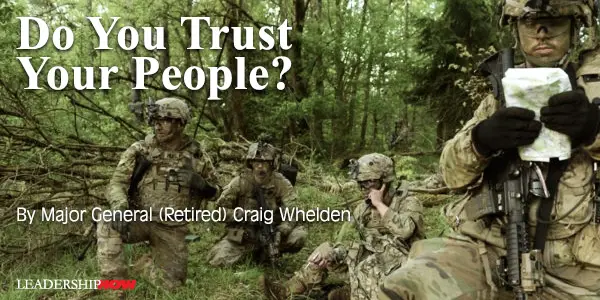
THE GREAT WRITER Ernest Hemingway once said: "The best way to find out if you can trust somebody is to trust them.” I’ve often told people in new organizations I joined that I trust them until that trust is violated. This puts a healthy kind of pressure on them NOT to violate that trust. Stronger performance is often the result. Here are two stories that demonstrate the value of trust: one that reflects what happens when there is no trust, and another that reflects the tremendous performance and learning that comes when there is trust. When No Trust Exists In 1992, I was the G3 (Operations Officer) for one of the Army’s 10 Divisions – forward deployed in Europe. Within a year in the job, I led a military-to-military exchange trip to Hungary, one of the satellite countries of the former Soviet Union. The Cold War had ended, and we were now opening the aperture to Eastern European countries that had been coerced into the Warsaw Pact decades earlier by the strong arm of Russia. After the Berlin Wall fell in 1989, General George Joulwan, the Supreme Allied Commander of all military forces in Europe, established a program called “Partnership for Peace” or PfP. His idea was to reach across the former Iron Curtain so new relationships could be forged between the U.S. and its former foes. The goal was to pull the Warsaw Pact nations out of Russia’s sphere of influence and into ours. My trip was the first such effort the U.S. military did with Hungary, and I was able to witness the difference in approaches to trust between the US military and the Eastern European military—and, by extension, the Russians, since Soviet satellite countries’ military dogma mirrored the mother ship. The Hungarians were truly trying to impress us when they showed us their weaponry, but they were seemingly unaware that the decades-old equipment they had was far inferior to ours if they had to face us in war. The Russians had given frontline nations in Eastern Europe the oldest and least capable equipment, saving the best for themselves. Soviet satellite countries such as Hungary, Czechoslovakia, Poland, and East Germany—rolled into the Soviet arc after World War II—were frankly viewed as cannon-fodder by the Russians. Although I was only a lieutenant colonel at the time, I was treated like a general. Everywhere I turned, only officers (majors and above) were briefing us. They had little trust in their more junior officers and sergeants, like the U.S. places in our junior leaders. Russian influence was everywhere, and the lack of trust and regimentation contrasted sharply with the way the U.S. military operates, where mission orders are issued along with the commander’s intent, thereby giving subordinates the freedom to operate within that framework. In the U.S. military, it’s all about trust and empowerment. I saw little of that in Hungary. A few months later, we reciprocated by bringing senior military leaders from Hungary to our bases in Germany. Most of these delegations consisted of colonels and generals. They were shocked when we turned them over to our sergeants (who actually gave the briefings) and even more shocked when we let them mingle with our troops—out of our earshot—to see what U.S. soldiers were really like. General Joulwan’s approach obviously worked, as a number of former Soviet Union countries are now members of the North Atlantic Treaty Organization (NATO): the Czech Republic, Poland, Bulgaria, Estonia, Latvia, Lithuania, Romania, Slovakia, Slovenia, Albania, Croatia, and Montenegro. And yes, Hungary. When Trust Exists I soon found myself on the list for both colonel and command. My boss called me in one day and told me that I had been selected to command a base. In fact, it was the base we were on: the 98th Area Support Group (ASG), headquartered right there in Wurzburg, Germany. Though I knew little about running a base, it took me just a few months to realize this turn of events was the best thing that ever happened to me. Over 95 percent of my 3,000-person workforce was civilian, half were females, and an equal number were German nationals. I was like a “town mayor” serving more than 45,000 constituents and customers. My leadership style needed to adapt to this very different environment, or I would fail. I was joining THEIR team and needed to learn quickly how to adapt to THEIR environment. Commanding a base required me to put trust, faith, and confidence in a workforce that knew much more about the tasks at hand than I did. I had to lead the team, but at the same time, I had to have confidence that their shared feedback and advice to me was of value. They needed to know that I trusted them. The leadership skills I employed at that time had little to do with the technical aspects of running an Army base, but rather, those that required skills in simply leading people; something I had spent 20 years honing. I found myself praising and encouraging what was working well, and just as importantly, I sought to learn what was not working well and how we could make it better. It wasn’t difficult sorting out the two, as all I had to do was pay attention to those on the receiving end of what we provided. Simply put, I listened to my “customers.” They could be very vocal when something wasn’t right. I understood this well since I too had been a customer of the community for the previous 18 months. This very different experience helped me grow as a leader and prepared me for the rest of my time in uniform and beyond. One of the keys to my success was rooted in the trust I showed my team. It was paid back in exceptional performance. It should be intuitive to most leaders that the higher you climb up the corporate ladder, the greater the reliance you must have on those below you. Support your team and let them do their job, and you’ll be amazed at what they give back. That’s what I tried to do in the 98th ASG, and it worked. It can work for you as well.  
Posted by Michael McKinney at 09:10 AM
11.20.17

8 Ways To Design a High-Trust Culture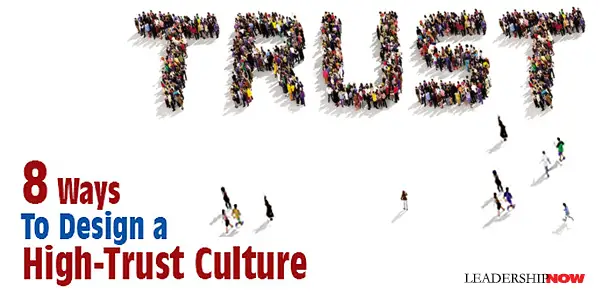
T Zak says that the most important thing to know is that “oxytocin works by activating a brain network that makes us more empathic.” He calls oxytocin “the moral molecule because when the brain releases it, we treat others well.” High levels of stress and testosterone inhibit the release of oxytocin. But here’s the good news. “You can actively promote oxytocin release and capture its benefits, including increased interpersonal trust and improved health, by modifying your default social behaviors.” Competition and status increases testosterone in both men and women. (Men have five to ten times more testosterone than women.) Promotion? Hot new romantic partner? Large bonus? “Testosterone whispers to our brains that we have won the social lottery and make us behave like demigods. It also increases libido. No surprise that CEOs, presidents, and movie stars have affairs.” Putting a check on your behavior will help you to produce a high-trust culture. Neuroscience has affirmed eight factors that are the building blocks of organizational trust. Zak has labeled these eight ways around the acronym OXYTOCIN. Ovation is recognizing colleagues who contribute to the organization’s success. Ovation should be unexpected, tangible, and personal. It should also be close in time (no more than a week), consistent, and done publically. eXpectation is setting difficult but achievable eXpectations. It engages the brain’s reward system, so that meeting goals at work becomes highly engaging and enjoyable. Challenging stress is good for you. Regular feedback on performance builds neural pathways in the brain that adapt behavior to meet goals. Yield means leaders must let go. Empower people to share their expertise and allow them to choose how to do projects. Instigate innovation by encouraging mistakes with limited downside and reward employees who make them. Train extensively and delegate generously. Transfer supports autonomy. Enables self-management by permitting colleagues to craft their own jobs. Facilitate self-mastery and skill development. Advise between teams without dictating. For transfer or self-management to be effective, Ovation, eXpectation, and Yield must be present in the organization. Openness involves keeping others informed. Sharing information broadly with colleagues and additionally, soliciting input and valuing the input of others. Organizational trust occurs when decisions are transparent, and reasons for decisions are shared. Caring is intentionally building relationships and prioritizing empathy. Supporting others. Letting people take the time to get to know each other increases trust. Emotions are recognized and accepted. Sometimes “difficult” people just need to be recognized and shown care. Peter Drucker said, “The number one practical competency for success in life and work is empathy.” Invest is committing to “whole person” development and work-life integration. Although it provides the foundation for a long-term commitment to the organization, investing in people is quite often just an afterthought. Do a Whole Person Review that asks three questions: Are you growing professionally? (Am I helping you to get your next job?) Are you growing personally? (Are you and your family happy?) Are you growing spiritually? (Are you developing as a human being?) Natural is allowing leaders and colleagues to be human, honest, and vulnerable. Ask for feedback on a daily or weekly basis. “A natural leader is one who accepts responsibility for mistakes and includes others in wins, who know the organization at every level, from the front lines to the executive suite.” Work the front lines at least one day a month. Trust when coupled with purpose results in joy at work. Working in a high-trust culture modestly increases joy. “Organizations should not try to make people happy at work. Joy is the result of working with trusted colleagues who have a transcendent purpose.” Joy=Trust x Purpose. Does your organization have a high-trust, high-performance culture? You can take the brief 16-question Ofactor Pulse & find out for sure. 
Posted by Michael McKinney at 07:43 AM
09.27.16

The 10 Laws of Trust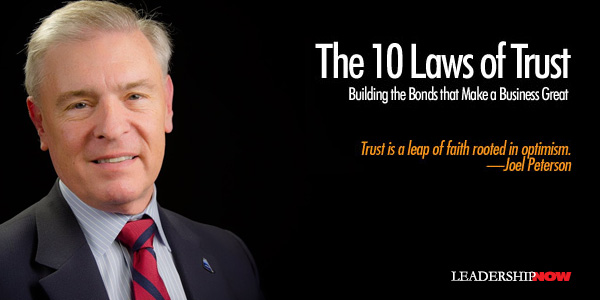
IN The 10 Laws of Trust, JetBlue Chairman and Stanford Professor Joel Peterson begins by reminding us that “when it comes to building great companies, a leader’s job isn’t to make it to the top of the mountain alone. Instead, the task is to help others reach peaks they want to climb but might not be able to without the help of the leader.” That leaves no room for distrust. “Trust is a leap of faith rooted in optimism.” It means giving away some control. Trust levels differ from organization to organization. While trust levels are not fixed, ‘what tends to motivate people within any organization tells you what level of trust you might realistically hope for.” So low-trust organizations rely on fear and high-trust organizations are motivated by duty and love. 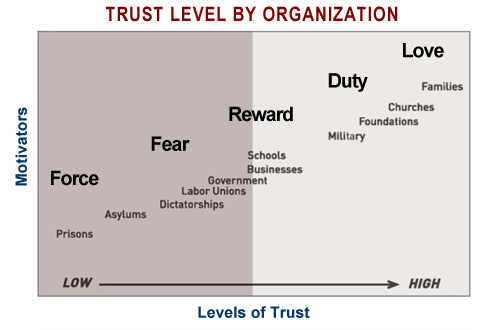 The goal of a leader is to move their organization to the high-trust duty and love end of the spectrum. Peterson offers 10 steps how to establish and maintain a culture of trust: 1. Start with personal integrity.
2. Invest in respect.
3. Empower others.
4. Measure what you want to achieve.
5. Create a common dream.
6. Keep everyone informed.
7. Embrace respectful conflict.
8. Show humility.
9. Strive for win-win negotiations.
10. Proceed with care.
Building or rebuilding a high-trust culture is a “patient, one-person-at-a-time, conversation-by-conversation process.” And forgive. 
Posted by Michael McKinney at 12:40 AM
02.26.13

5 Key Practices to Earn Trust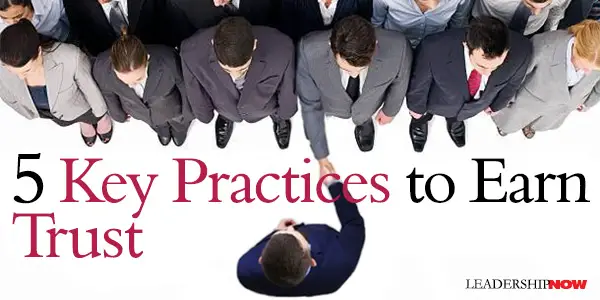
TO TRUST or not to trust is a decision we all make every day. As leaders, we can influence people’s decision to trust not only us, but others in the organization and even the organization itself. Robert Hurley has identified ten specific trust factors in The Decision to Trust. The first three factors are trustor-related: the level of risk tolerance, the trustor’s level of psychological adjustment, and the power position of the trustor.
With these ten factors in mind, you can more easily diagnose why trust may be (or likely to be) high or low in your organization. You can also see what you are contributing to the situation—positively or negatively. Here are five key practices to earn trust: 1. Align your interests with those whose trust you want. High trust leaders try to move their enterprise together by encapsulating stakeholders’ interests not pitting stakeholders against one another. If you want to build trust, start by clarifying and aligning stakeholder interests and prove that you will promote those interests in a fair manner. This may seem to go without saying, but “one of the reasons that trust has broken down in business and society in general is that there are many situations where the complexity of misaligned interests is not acknowledged, must less dealt with.” In these situations, “the best you can do is be clear about interests, decide whose interests will be primary or secondary, and be transparent about what trade-offs you are making and why.” 2. Demonstrate Benevolent Concern. We tend to trust people who we believe will care about our welfare—they demonstrate a benevolent character. People, who appear concerned only with themselves, engender distrust. If you want to earn trust, demonstrate to others that you will do the right thing for them even if it puts you at risk. “Demonstrate a respect for others and understand others’ needs in a way that helps them find win-win solutions.” 3. Develop and demonstrate Capability in the Matter at Hand. We are only trustworthy if we can deliver on our commitments. Good intentions, benevolence, and even ethical conduct, do not warrant trust if the other person is incompetent. High trust leaders make sure that there is a reasonable probability and capability to deliver before they make promises. 4. Create a track record of Predictability and Integrity. High trust leaders tend to practice values based leadership, which creates consistency and coherence in their behavior. Trust comes from always striving to honor ones word. 5. Communicate, communicate, communicate and do it clearly and openly. Because is largely about relationships, communication is critical. Communication is also the vehicle through which the other four elements of trustworthiness are delivered. Aligning interests, demonstrating benevolence, accurately communicating ones capability and practicing what you preach all require effective communication skills. Spirals of distrust often begin with miscommunication, leading to perceived betrayal causing further impoverishment of communication and ending in a state of chronic distrust. Open and transparent communication can induce others to open up and reciprocate with feelings of confident reliance. Of Related Interest:

Posted by Michael McKinney at 10:10 AM
11.12.12

The Eight Pillars of Trust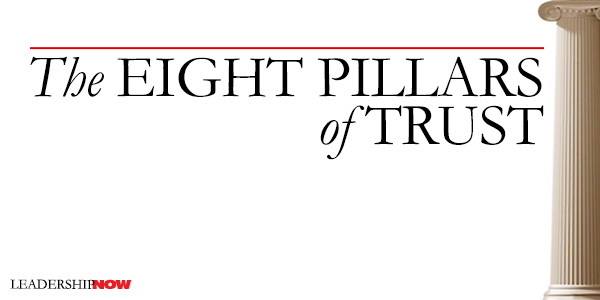
EVERYTHING of value is built on trust. The Trust Edge explains how you and your organization can become trusted. A lack of trust is your biggest expense. It is the currency of business and life. Author David Horsager, explains that trust is tangible, learnable, and measureable. Trust is a confident belief in someone or something to do what is right, deliver what is promised, and to be the same every time in spite of circumstances. Horsager identifies twelve barriers to trust: conflict of interest, threat of litigation, lack of loyalty, increasing examples of others untrustworthiness, threat of exposure, lack of control over technology, fear of the unknown, negative experiences, individualism, differences between people, desire for instant gratification, and a focus on the negative.
The eight pillars of trust form the framework for learning to build trust and overcoming the twelve barriers. These all take time and are not quick fixes for any trust issue. Trust is built over time. Clarity. Clarity starts with honesty. People trust the clear and distrust the vague. Communicate clearly and frequently. Compassion. Think beyond yourself. There are four keys ways we show we care: listen, show appreciation, be engaged, and serve others. Character. Have high morals and be consistent in your thoughts, words, and actions. Always ask, “Am I doing the right thing?” Competency. Humility is the first step in learning. Create a regular plan for staying competent and capable. Commitment. Great leadership demands sacrifice. The people who stick with you when things are tough are the ones you can really trust. Connection. Trust is about relationships. In every interaction we increase or decrease trust. Be genuine, be grateful and avoid gossip. Contribution. You must deliver results to be trusted. Give attention, resources, time, opportunity, and help. Consistency. Probably the most important pillar of all as it gives meaning to all of the other pillars. You will never get one big chance to be trusted in your life; you will get thousands of small ones. Just one inconsistency can change people’s perspective. Horsager notes that in this flat world, because we can connect with so many, we have a hard time cultivating depth. Trust at its best is deep, making it difficult to gain the trust edge. In response we need to be even more intentional about developing the pillars of trust on a global level finding common ground and showing ourselves to be trustworthy.

Posted by Michael McKinney at 11:57 PM
08.26.11

Credibility: How Leaders Gain it and Lose It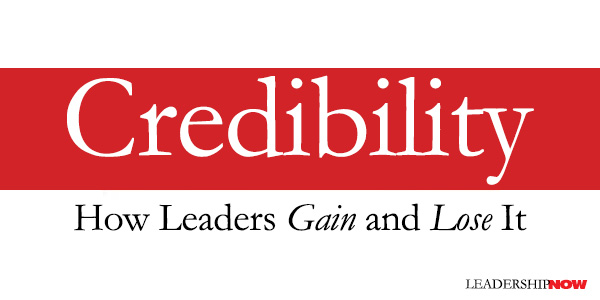
CREDIBILITY is the foundation of leadership. Unfortunately, many people today do not trust their leaders. “Many wonder if there are any leaders left who have the strength of character to sustain their trust,” write Jim Kouzes and Barry Posner in Credibility: How Leaders Gain it and Lose It – Why People Demand It. While there is no single reason for it, “there is the gnawing sense in many corridors that leaders are not competent to handle the tough challenges; that they are not telling the truth; and that they are motivated more by greed and self-interest than concerns for the customer, the employees, or the country.” The time is ripe to revisit this topic. Credibility is a wake-up call to get back to the fundamentals; to remember that leadership is about relationships. “The secret to closing the credibility gap lies in a collective willingness to get closer, to become known, and to get to know others—as human beings, not as demographic categories, psychographic profiles, voting statistics, or employee numbers.”The process of building and sustaining credibility requires six disciplines: discover your self, appreciate constituents, affirm shared values, develop capacity, serve a purpose, and sustain hope. The authors devote a chapter to each of these issues. Personal responsibility is key to building and restoring credibility. Personal responsibility means understanding not only your actions, but the likely consequences and attending to them. Kouzes and Posner suggest following the “Six A’s of Leadership Accountability”: accept, admit, apologize, act, amend, attend. Leadership isn’t easy and in a constantly changing world, things like credibility and competency can seem elusive. But if we act on a daily basis, “in ways that increase people’s belief that we are honest, competent, inspiring, and forward-looking, people will be much more likely to want to follow your direction.” When leaders walk the talk, others are more likely to follow. Some leaders think that credibility once demonstrated and earned, is complete. But it must be renewed daily in everything we do. Unfair or not, it is the life that a good leader has chosen and demonstrates the understanding that the function of leaders is to serve, not be served. Credibility is an important book to help you sustain your influence. They conclude: Renewing credibility is a continuous human struggle and the ultimate leadership struggle. Strenuous effort is required to build and strengthen the foundations of working relationships. Constituents do not owe leaders allegiance. Leaders earn it. The gift of another’s trust and confidence is well worth the struggle and essential to meeting the challenges of leading people to places they have never been before. 
Posted by Michael McKinney at 04:46 PM
08.03.11

7 Ways to Increase Trust by Creating Stability Uncertain times always invite a little more drama, particularly in the workplace. One reason is because the brain craves certainty. When you feel uncertain, the amygdala, an almond shaped structure in the brain shoots out chemicals through your blood stream that make you experience feelings of fear, doubt and anxiety. Fortunately leaders can use this information to create a sense of stability in an unstable world, which increases and eliminates much of the unnecessary drama plaguing so many workplaces today. Here are seven ways leaders can increase trust and reduce workplace drama by creating a stable environment and seven questions to help you get to the root of the problem. Be clear Just because you are unclear does not mean you have drama, but I can guarantee where ever there is drama there is a lack of clarity in some area. The lack of clarity could be in your policies, mission statement, job descriptions or even the methods of communication. When there seems to be negativity or any other form of drama, ask the question, “Where might there be a lack of clarity?” Be Consistent Often a leader can add to the confusion unintentionally because of personality and wiring. In my book, Stop Workplace Drama I talk about the creative genius boss and the idealist, two traits often found in high driving entrepreneurial types. The creative genius drives employees crazy with “flavor of the month” ideas and emergency deadlines only to change course at a whim. The idealist contributes to lack of consistency by starting out strong then losing momentum when the new wears off, or when realism sets in and resources are scarce. When you see the morale dipping or you sense a lack of engagement, ask the question, “How might my behaviors be perceived as inconsistent?” Shorten the Gap Most of us know from experience that plans that look good on paper don’t always work in the real world. One way to keep clarity and consistency is to shorten the gap. In other words, chunk down the goals into very small measurable parts. The idea here is to give the vision and the overview, but explain that plans may change as new information emerges. Then at the designated stopping places, celebrate the successes and then explain the next few projects and pieces and how the changes will contribute to the stated goals. When you get ready to make a change, always provide a pilot period for the change rather than announce the change is here to stay. When you see negativity, frustration or overwhelm, ask the question, “Where do I need to shorten the gap so it seems easy?” Keep your Word When you are in the midst of change, regular communication, scheduled communication and documented promises are a must. Even a simple, “I’ll get back with you” can create a sense of uncertainty and inconsistency if you don’t do what you say you are going to do. When you say, “I will let you know” or “I’ll get back to you on that,” schedule a time in your blackberry or calendar and make sure you follow through. Make your word golden and you will build loyalty and trust in your organization. When you stop getting ideas, curiosity and questions, ask yourself the question, “Where do I need to follow up or tie up loose ends?” Listen Every time I have interviewed employees on what makes a good boss, listening is always the first response, and respect is the second. Rather than always being the one with the answers, learn how to ask a good question. When you really listen, you increase engagement, which is always a sign of trust. The good thing about listening is remembering that you don’t have to have all the answers. When you start to feel overwhelmed, stuck or confused, ask yourself, “What could I learn from my employees if I was willing to listen?” Respect Before I became a professional speaker and trainer I had some bad habits unbeknownst to me. I would either roll my eyes, or use sarcasm as a way to keep people at a distance when I did not agree or when I felt misunderstood. I was not aware of these habits until someone pointed it out to me. Eye-rolling, interrupting, or using innuendo and sarcasm may keep people in their place, but these habits will also build a barrier instead of a bridge. In addition, you will be viewed as a persecutor instead of as a leader. If you perceive distance from your peers or your employees, ask yourself, “What habits do I have that could communicate disrespect?” Master Your Self William Penn said, “No man is fit to command another who cannot command himself.” As a leader, the worst thing you can do is to let your emotions rule you. No matter what the reason, flying off the handle, cursing, yelling or throwing fits does not benefit your corporate goals or inspire your team. No one wants to work for a bully or a hot head. Excuses such as “that’s just the way I am,” or “You would feel the same way” indicates a lack of discipline and emotional maturity. If you feel the pressures piling up and you have difficulty mastering yourself, ask yourself these questions: “Is my behavior and thoughts adding value,” and “How can I get my needs met so I can represent myself appropriately?” Tumultuous times offer great opportunities to increase your leadership skills. Rather than focusing on the outside circumstances, now is the time to become a creator and lead from within by creating stability even in difficult times. Marlene Chism is a professional speaker, trainer and the author of Stop Workplace Drama. For more information visit www.marlenechism.com or at www.stopworkplacedrama.com
Posted by Michael McKinney at 10:40 PM
10.11.06

What is Trust?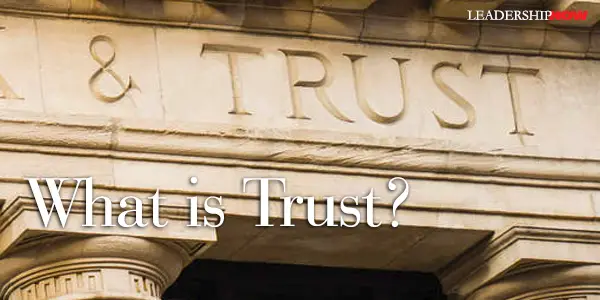
David Abshire, President of the Center for the Study of the Presidency, in a speech delivered this summer had this to say about trust:
Posted by Michael McKinney at 08:59 AM
|
BUILD YOUR KNOWLEDGE
 

How to Do Your Start-Up Right STRAIGHT TALK FOR START-UPS 
Grow Your Leadership Skills NEW AND UPCOMING LEADERSHIP BOOKS 
Leadership Minute BITE-SIZE CONCEPTS YOU CAN CHEW ON 
Classic Leadership Books BOOKS TO READ BEFORE YOU LEAD |
|